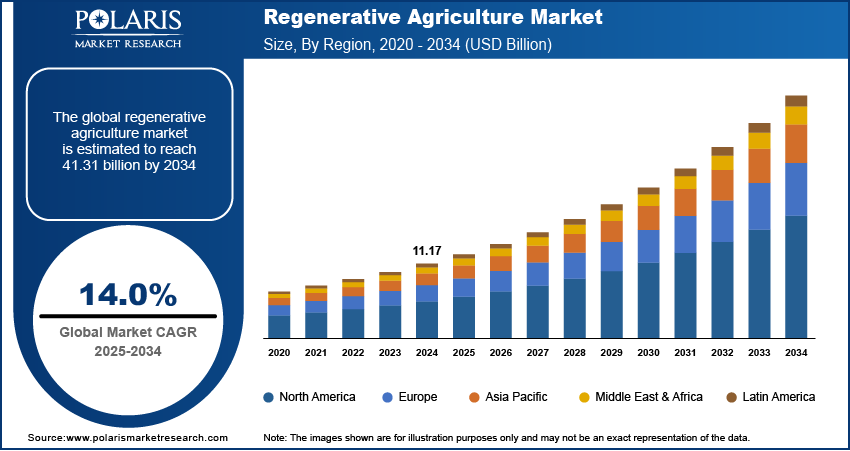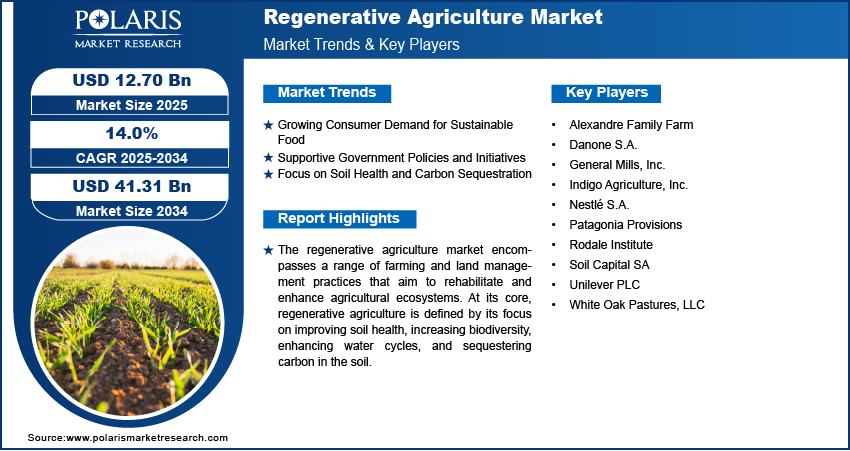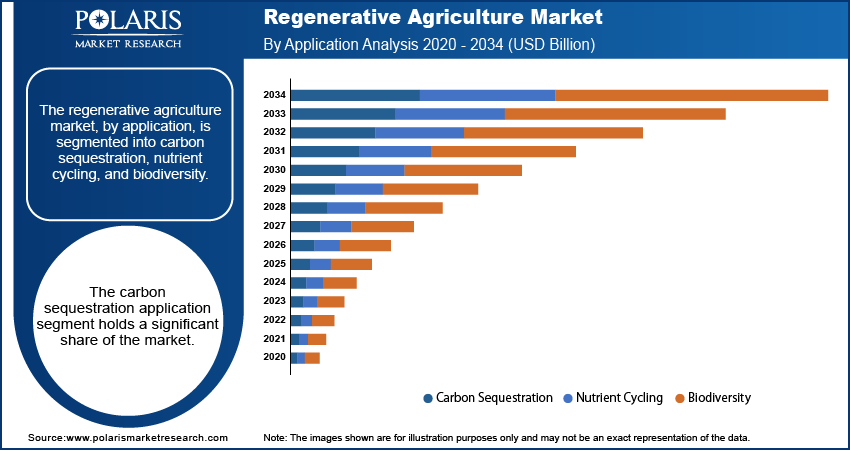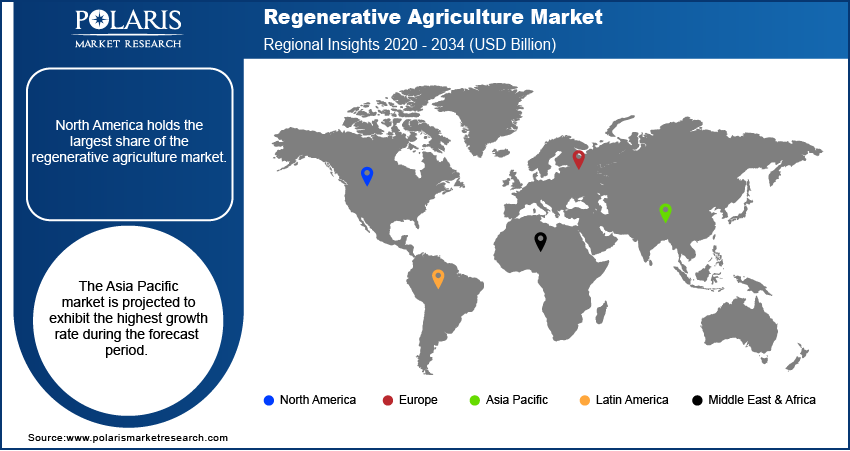
Regenerative Agriculture Market Size, Share, Trends, Industry Analysis Report
: By Application (Carbon Sequestration, Nutrient Cycling, and Biodiversity), By Practice, and By Region – Market Forecast, 2025–2034
- Published Date:May-2025
- Pages: 120
- Format: PDF
- Report ID: PM2462
- Base Year: 2024
- Historical Data: 2020-2023
Market Overview
The regenerative agriculture market size was valued at USD 11.17 billion in 2024. It is projected to grow from USD 12.70 billion in 2025 to USD 41.31 billion by 2034, exhibiting a CAGR of 14.0% during 2025–2034.
The regenerative agriculture market represents a paradigm shift in farming practices, moving beyond mere sustainability to actively improve and revitalize agricultural ecosystems. At its core, regenerative agriculture is a holistic approach to land management that prioritizes soil health, enhances biodiversity, increases water retention, and sequesters carbon. Unlike conventional methods that can deplete soil fertility over time, regenerative practices aim to restore the natural balance of the land, leading to more resilient and productive agricultural systems. This approach encompasses a variety of techniques, including no-till and vertical farming, cover cropping, crop rotation, the integration of livestock, and agroforestry, all tailored to the specific ecological context of the farm. The fundamental goal is to create a living soil that is rich in organic matter and microbial activity, capable of supporting healthy plant growth and contributing to a more stable environment.

To Understand More About this Research: Request a Free Sample Report
Market Dynamics
Growing Consumer Demand for Sustainable Food
The increasing awareness among consumers regarding the environmental and health impacts of food production is a significant market driver for regenerative agriculture. Individuals are progressively seeking food options that are nutritious and produced through methods that minimize harm to the planet. This growing demand is evident in the increasing sales of organic and sustainably labeled products. For instance, a survey highlighted by Food Dive in February 2024 indicated that a majority of Americans are willing to pay more for sustainably produced food, demonstrating a clear consumer preference for environmentally conscious options. This shift in consumer behavior is compelling food companies and agricultural producers to adopt regenerative practices to meet this evolving demand and gain a competitive edge. As consumers become more educated about the benefits of regenerative agriculture, including improved soil health and reduced environmental impact, their demand for sustainable food products will likely intensify, further propelling the regenerative agriculture market growth.
Supportive Government Policies and Initiatives
Government bodies worldwide are increasingly recognizing the critical role of agriculture in addressing climate change and environmental degradation, leading to the implementation of supportive policies and initiatives that act as a substantial market drive for regenerative agriculture. These policies often include financial incentives, research funding, and technical assistance to encourage farmers to adopt regenerative practices. For example, the Paramparagat Krishi Vikas Yojana (PKVY) in India, as mentioned on the PMF IAS website in January 2025, promotes organic farming and the establishment of organic value chains, which aligns with the principles of regenerative agriculture. Similarly, many governments offer environmental stewardship schemes that provide financial support to farmers for implementing practices such as cover cropping and reduced tillage, as highlighted by Future Food Solutions in September 2024. Hence, the supportive government policies and initiatives accelerate the adoption of regenerative agricultural practices.
Focus on Soil Health and Carbon Sequestration
The growing understanding of the critical link between soil health, climate change, and agricultural productivity is a major market growth factor for regenerative agriculture. Regenerative practices are specifically designed to enhance soil health by increasing organic matter, improving water retention, and fostering biodiversity. Healthy soils also play a crucial role in carbon sequestration, drawing carbon dioxide from the atmosphere and storing it in the ground, thus mitigating climate change. Research published in Nature Food in September 2024 by IIASA highlights the significant potential of agricultural land for carbon sequestration through practices such as cover cropping and agroforestry. The recognition of these dual benefits – improved soil fertility and climate change mitigation – is driving increased interest and investments in regenerative agriculture from various stakeholders, including farmers, researchers, and environmental organizations. Thus, rising focus on soil health and carbon sequestration would offer lucrative growth opportunities for the industry during the forecast period.

Segment Insights
Market Assessment – By Application
The regenerative agriculture market, by application, is segmented into carbon sequestration, nutrient cycling, and biodiversity. The carbon sequestration segment holds a significant share of the market. This is primarily driven by the increasing recognition of agriculture's potential to mitigate climate change. With growing awareness of the detrimental effects of greenhouse gases, there is a strong impetus to adopt farming practices that can capture and store atmospheric carbon in the soil. Regenerative agriculture techniques, such as cover cropping, no-till farming, and agroforestry, are highly effective in enhancing soil organic matter, which acts as a major carbon sink. This capability positions carbon sequestration as a key application area attracting substantial attention and investments in the regenerative agriculture landscape, supported by both environmental concerns and potential carbon credit opportunities.
The biodiversity segment is anticipated to exhibit the highest growth rate during the forecast period. As the ecological consequences of conventional agriculture, including habitat loss and reduced species richness, become more apparent, there is a growing emphasis on farming systems that actively promote and restore biodiversity. Regenerative practices, by their very nature, aim to create more diverse and resilient agroecosystems. Integrating livestock in a managed way, planting diverse cover crops, and reducing the use of synthetic pesticides and fertilizers contribute to healthier soil ecosystems and provide habitats for a wider range of flora and fauna. This increasing focus on ecological health and the recognition of the interconnectedness of biodiversity with long-term agricultural sustainability are expected to drive significant expansion of the biodiversity segment in the coming years.
Market Evaluation– By Practice
The regenerative agriculture market, by practice, is segmented into aquaculture, holistic planned grazing, agroecology, agroforestry, biochar, pasture cropping, silvopasture, and others. The holistic planned grazing segment holds a significant share of the market. This prominence stems from the increasing recognition of the environmental benefits of carefully managed livestock grazing, particularly its ability to improve soil health, enhance carbon sequestration in grasslands, and restore ecosystem function. As awareness grows regarding the negative impacts of conventional grazing practices, holistic planned grazing is gaining traction as a viable and scalable regenerative agriculture method, attracting a considerable number of farmers and ranchers seeking sustainable land management solutions.
The agroforestry segment is anticipated to exhibit the highest growth rate during 2025–2034. Agroforestry systems, which integrate trees and shrubs into crop and animal farming systems, offer a multitude of ecological and economic benefits. These include enhanced biodiversity, improved soil fertility, increased carbon sequestration, and diversified income streams for farmers. With the escalating focus on climate and smart agriculture and the growing understanding of the long-term sustainability advantages of integrating woody vegetation into agricultural landscapes, the adoption of agroforestry practices is expected to accelerate significantly.

Regional Analysis
Based on region, the regenerative agriculture market is segmented into North America, Europe, Asia Pacific, Latin America, and the Middle East & Africa. North America and Europe have emerged as early adopters, driven by strong consumer demand for sustainably produced food and supportive government initiatives. The Asia Pacific market is witnessing increasing momentum, fueled by growing environmental concerns and a rising awareness of the benefits of regenerative practices for long-term agricultural sustainability. Latin America and the Middle East & Africa are also showing potential, with increasing interest in adopting regenerative methods to address specific regional challenges such as soil degradation and water scarcity. The industry dynamics across these regions are influenced by a complex interplay of factors, including consumer preferences, government regulations, agricultural traditions, and climatic conditions.
North America holds the largest share of the regenerative agriculture market. This significant market share can be attributed to a confluence of factors, including a well-established organic food sector, proactive government support for sustainable farming, and a strong presence of key industry players promoting regenerative practices. Furthermore, a higher level of consumer awareness and purchasing power in the region contributes to the greater demand for regeneratively produced goods. The presence of robust research and development activities, coupled with established distribution channels for sustainable products, further solidifies North America's leading position in the global regenerative agriculture landscape.
The Asia Pacific market is projected to exhibit the highest growth rate in the coming years. This rapid growth is driven by a confluence of factors, including a large agricultural base facing increasing pressure from conventional and precision farming practices, growing awareness of environmental degradation and climate change impacts, and rising government support for sustainable agriculture. Furthermore, increasing disposable incomes and a growing middle-class population are leading to a greater demand for healthier and more sustainably produced food options. With a significant potential for the adoption of regenerative practices across its diverse agricultural systems, Asia Pacific presents substantial opportunities for market penetration and expansion, making it the fastest-growing market for regenerative agriculture globally.

Key Players and Competitive Insights
A few key players actively contributing to the regenerative agriculture market include Indigo Agriculture, Inc. (Indigo Ag, Inc.); General Mills, Inc.; Danone S.A.; Unilever PLC; Nestlé S.A.; Patagonia Provisions (Patagonia, Inc.); White Oak Pastures, LLC; Alexandre Family Farm; Rodale Institute; and Soil Capital SA. These entities are involved in various aspects of the market, from implementing regenerative practices on farmland and sourcing regeneratively produced ingredients to providing solutions and support for farmers transitioning to these methods.
The competitive landscape of the regenerative agriculture industry is characterized by a mix of established food and agriculture companies and newer, specialized organizations. Competition is intensifying as the demand for sustainably produced food grows and the benefits of regenerative agriculture become more widely recognized. Key competitive factors include the ability to establish robust supply chains for regeneratively sourced ingredients, the development of effective and scalable regenerative farming solutions, and the capacity to meet increasing consumer demand for transparency and environmental stewardship. Collaborations and partnerships across the value chain, from farmers to food manufacturers and retailers, are becoming increasingly important for industry penetration and achieving widespread adoption of regenerative practices.
Indigo Agriculture, Inc. is headquartered in Boston, Massachusetts, USA. The company offers a range of solutions aimed at promoting regenerative farming practices, including microbial seed treatments, digital platforms for farmer management, and carbon farming initiatives that help farmers generate and sell carbon credits.
General Mills, Inc. is a global food company based in Minneapolis, Minnesota, USA. General Mills has made public commitments to advance regenerative agriculture across its sourcing practices for key ingredients. They work directly with farmers to implement regenerative techniques on their land, focusing on improving soil health, reducing emissions, and enhancing biodiversity within their agricultural supply chains.
List of Key Companies in Regenerative Agriculture Market
- Alexandre Family Farm
- Danone S.A.
- General Mills, Inc.
- Indigo Agriculture, Inc.
- Nestlé S.A.
- Patagonia Provisions
- Rodale Institute
- Soil Capital SA
- Unilever PLC
- White Oak Pastures, LLC
Regenerative Agriculture Industry Developments
- April 2024: Cargill and Nestlé Purina partnered to invest in farmers implementing regenerative agriculture practices across their maize and soy supply chains. This initiative supports a more sustainable future for people and pets by enhancing soil health and reducing the carbon footprint of Purina’s dry pet food products across North America.
- September 2023: Soil Capital joined forces with Regrow Ag to advance the transition to regenerative agriculture and expand their impact throughout Europe.
Regenerative Agriculture Market Segmentation
By Application Outlook (Revenue – USD Billion, 2020–2034)
- Carbon Sequestration
- Nutrient Cycling
- Biodiversity
By Practice Outlook (Revenue – USD Billion, 2020–2034)
- Aquaculture
- Holistic Planned Grazing
- Agroecology
- Agroforestry
- Biochar
- Pasture Cropping
- Silvopasture
- Others
By Regional Outlook (Revenue – USD Billion, 2020–2034)
- North America
- US
- Canada
- Europe
- Germany
- France
- UK
- Italy
- Spain
- Netherlands
- Russia
- Rest of Europe
- Asia Pacific
- China
- Japan
- India
- Malaysia
- South Korea
- Indonesia
- Australia
- Vietnam
- Rest of Asia Pacific
- Middle East & Africa
- Saudi Arabia
- UAE
- Israel
- South Africa
- Rest of Middle East & Africa
- Latin America
- Mexico
- Brazil
- Argentina
- Rest of Latin America
Regenerative Agriculture Market Report Scope
|
Report Attributes |
Details |
|
Market Size Value in 2024 |
USD 11.17 billion |
|
Market Size Value in 2025 |
USD 12.70 billion |
|
Revenue Forecast by 2034 |
USD 41.31 billion |
|
CAGR |
14.0% from 2025 to 2034 |
|
Base Year |
2024 |
|
Historical Data |
2020–2023 |
|
Forecast Period |
2025–2034 |
|
Quantitative Units |
Revenue in USD billion and CAGR from 2025 to 2034 |
|
Report Coverage |
Revenue Forecast, Market Competitive Landscape, Growth Factors, and Industry Insights |
|
Segments Covered |
|
|
Regional Scope |
|
|
Competitive Landscape |
|
|
Report Format |
|
|
Customization |
Report customization as per your requirements with respect to countries, regions, and segmentation. |
How is the report valuable for an organization?
Workflow/Innovation Strategy
The regenerative agriculture market has been segmented into detailed segments of application and practice. Moreover, the study provides the reader with a detailed understanding of the different segments at both the global and regional levels.
Market Entry Strategies
A successful growth and marketing strategy for the market hinges on educating stakeholders about its multifaceted benefits, from enhanced soil health and biodiversity to climate change mitigation and potential for premium pricing. Collaborations across the value chain, involving farmers, food processors, retailers, and consumers, are crucial for building trust and ensuring market access. Emphasizing the long-term economic and environmental sustainability offered by regenerative practices, supported by transparent certification and verification systems, will drive wider adoption. Furthermore, leveraging digital platforms for storytelling, farmer support, and connecting consumers with regeneratively produced goods can amplify market reach and foster a loyal customer base.
FAQ's
The market size was valued at USD 11.17 billion in 2024 and is projected to grow to USD 41.31 billion by 2034.
The market is projected to register a CAGR of 14.0% during the forecast period, 2024-2034.
North America had the largest share of the market in 2024.
A few players in the market include Indigo Agriculture, Inc., (Indigo Ag, Inc.), General Mills, Inc., Danone S.A., Unilever PLC, Nestlé S.A., Patagonia Provisions (Patagonia, Inc.), White Oak Pastures, LLC, Alexandre Family Farm, Rodale Institute, and Soil Capital SA.
The holistic planned grazing segment accounted for the larger share of the market in 2024.
Following are a few of the market trends: ? Growing Emphasis on Soil Health and Carbon Sequestration: Increasing recognition of the importance of healthy soils for agricultural resilience, productivity, and their role in capturing atmospheric carbon. ? Rising Consumer Demand for Sustainable and Organic Food: Consumers are increasingly seeking food produced through environmentally friendly practices, driving demand for regeneratively grown products. ? Expansion of Carbon Credit Programs: Development of markets where farmers can earn revenue by sequestering carbon in their soil through regenerative practices.
Regenerative agriculture is a holistic approach to farming that goes beyond sustainable practices by actively aiming to improve and revitalize agricultural ecosystems. It focuses on enhancing soil health, increasing biodiversity, improving water retention, and sequestering carbon from the atmosphere. Unlike conventional methods that can degrade soil over time, regenerative agriculture employs techniques that mimic natural processes to build a more resilient and productive farming system. The core principle is to create living, healthy soil that supports thriving plant life and contributes to a healthier environment overall.
